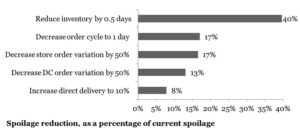
Digitalization: a fresh idea for the fruit and veg supply chain
The cost of global food waste and loss is estimated to be $940 billion a year. For businesses, this represents a significant proportion of shrinkage in retail supply chains and it has a direct impact on companies’ triple bottom lines. There could be a great opportunity here for cost savings and to reduce environmental and social footprints, but making this happen remains a complicated problem, requiring solutions at all levels of the supply chain.
Fresh fruit and vegetables are a challenging retail category because of the very short product lifetimes. To identify drivers of spoilage, we examined the supply chain of Migros, Switzerland’s largest grocery retailer with 27.4 billion Swiss Francs in sales and a market share above 20%. Its fruit and vegetable sales account for more than 10% of total supermarket sales in the country. It’s a highly competitive product group that generates shop flow, requires high availability and specialized infrastructure. Plus, its portfolio must change with the seasons.
In terms of sales, best-practice retailers have spoilage levels of between 3% and 5%. Migros is among these best-practice retailers but for such a large operator, even these small spoilage levels have a significant impact on its annual profit in the fresh fruit and vegetables category.
Our in-depth analysis was based on roughly half a million data points of 100 fresh products on a day and store basis. It revealed three major drivers for spoilage:
1] Excess inventory
2] Order cycles and variation
3] Longer delivery lead times
The best way to reduce spoilage is to reduce the inventory in stores (see the graph below). A half-day reduction would reduce overall spoilage costs by 40%. Smoothing both store and distribution center (DC) orders by 50% would improve spoilage costs by 30%. Increasing the order frequency to daily would reduce spoilage costs by 17%. And reducing delivery times by one day in 10% of deliveries could reduce spoilage by 8%.
How can businesses achieve these reductions in spoilage costs?
Employee training and incentive schemes can go some way to reducing order cycles and making other improvements in freshness and shrinkage performance. The greatest potential, however, comes from supply chain digitalization to match demand with supply.
We recommend three main areas for digital development to address the major drivers of spoilage we identified in our study: data management; integrated collaborative forecasting; and product tracking.
1] Data management
This is essential for better ordering, establishing adequate inventory levels and enabling transparency within firms. The longer it takes to get hold of information, the harder it is to create accurate demand forecasts. Here are three steps for digitalizing supply chain data:
- Get accurate historical data. High-quality demand forecasting depends on this, plus it helps to reduce excessive ordering or unmet demand. This historical data can then be integrated into ordering tools to make ordering easier and to increase transparency.
- Use live point-of-sale (POS) data (but only after you are assured of the accuracy of the data). Accurate, live POS information can help decrease information lead time, so your supply chain can become more responsive to fluctuations in demand.
- Automate orders. Historical data coupled with live POS data create an opportunity to automate orders in real time. This allows companies to overcome issues related to order batching, which often causes excess inventory and spoilage in perishable product supply chains. Automation has a substantial potential here because ordering activities often take up considerable time and resources.
2] Integrated collaborative forecasting
This addresses high order variation caused by rationing and shortage gaming, and long transportation lead times. Integrating data systems for collaborative forecasting increases visibility, and reduces the risk of overstock or stock-outs along the supply chain. The benefits of visibility of supply chain partner forecasts can further extend to the physical chain, allowing for shorter delivery lead times because deliveries don’t need to be as flexible.
3] Product tracking
This means having digital records for the entry and exit of products at each stage of the supply chain. It can help ensure a ‘first in, first out’ policy for fresh products, which will decrease inventory age – and therefore reduce shrinkage due to spoilage. Shrinkage rates represent up to 15% of sales in major retailers.
Digital supply chain solutions, therefore, provide enormous potential for accurate demand forecasting and better inventory management. However, the improvements do not come for free in this high-paced category. Product yields, volatile prices, fragmented suppliers, specific supply chain configuration, as well as perishability and quality issues, all mean that the value drivers are diverse and category-specific.
Before implementing new digital solutions, it is vital to interview individuals along the entire supply chain and analyze existing data to work out what business impact those solutions might have.
Ralf Seifert is Professor of Operations Management at IMD. He directs IMD’s new Digital Supply Chain Management program, which addresses both traditional supply chain strategy and implementation issues as well as digitalization trends and new technologies.
Merve Kirci is a doctoral researcher in College of Management of Technology at EPFL. Her research addresses strategic and operational improvements in food supply chains.
Reference:
Mervegül Kırcı, Olov Isaksson and Ralf W. Seifert, 2016. Managing Perishability in the Fruit and Vegetable Supply Chain.
©: Keilidh Ewan / Unsplash
Research Information & Knowledge Hub for additional information on IMD publications
The supply chain risk management literature differentiates between disruption risk that arises from supply disruptions to normal activities and recurrent risk that arises from problems in coordinating supply and demand in the absence of disruption...
In the 2010s, card processing – Mastercard’s flagship service – started showing signs of commodification as new, nimble players (typically, fintech startups thriving on digital) entered the payment processing space, and customer preferences evolve...
Supply chain management experts Ralf Seifert and Richard Markoff pose the question: is fulfilment still an FMCG core competency?
Improvements in technology have made deepfakes — fraudulent audio, video, and images — easier than ever to create. As a result, 2024 has seen a nearly 60% surge in phishing attacks. These attacks hijack our perceptions and our ability to distingui...
Nowadays, deploying artificial intelligence no longer guarantees a competitive edge. What truly sets companies apart is access to diverse, extensive, high-quality data that enhances their AI system’s performance compared with that of their competi...
As society moves further into the digital age, emerging technologies bring unprecedented opportunities for economic growth, operational efficiency and societal advances. Emerging technologies such as artificial intelligence (AI), quantum computing...
The AI boom — and the growth of gen AI in particular — has introduced new points of conflict between employees and companies. Some of these have already started to play out, such as in the Writers Guild of America strike over how AI can and can’t ...
in Production and Operations Management 16 November 2024, ePub before print, https://doi.org/10.1177/10591478241302735
Research Information & Knowledge Hub for additional information on IMD publications
IMD World Competitiveness Center Report, 14 November 2024, 8th edition
Research Information & Knowledge Hub for additional information on IMD publications
Research Information & Knowledge Hub for additional information on IMD publications
Research Information & Knowledge Hub for additional information on IMD publications
Research Information & Knowledge Hub for additional information on IMD publications
in MIT Sloan Management Review Blog 16 October 2024
Research Information & Knowledge Hub for additional information on IMD publications
Research Information & Knowledge Hub for additional information on IMD publications
Research Information & Knowledge Hub for additional information on IMD publications
Research Information & Knowledge Hub for additional information on IMD publications
Research Information & Knowledge Hub for additional information on IMD publications

